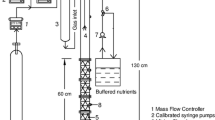Abstract
A 2-l (1-l working volume) two-phase partitioning bioreactor (TPPB) was used as an integrated scrubber/bioreactor in which the removal and destruction of benzene from a gas stream was achieved by the reactor's organic/aqueous liquid contents. The organic solvent used to trap benzene was n-hexadecane, and degradation of benzene was achieved in the aqueous phase using the bacterium Alcaligenes xylosoxidans Y234. A gas stream with a benzene concentration of 340 mg l−1 at a flow rate of 0.414 l h−1 was delivered to the system at a loading capacity of 140 g m−3 h−1, and an elimination capacity of 133 g m−3 h−1 was achieved (the volume in this term is the total liquid volume of the TPPB). This elimination capacity is between 3 and 13 times greater than any benzene elimination achieved by biofiltration, a competing biological air treatment strategy. It was also determined that the evaluation of TPPB performance in terms of elimination capacity should include the cell mass present in the system, as this is a readily controllable quantity. A specific benzene utilization rate of 0.57 g benzene (g cells)−1 h−1 was experimentally determined in a bioreactor with a cell concentration that varied dynamically between 0.2 and 1 g l−1. If it assumed that this specific benzene utilization rate (0.57 g g−1 h−1) is independent of cell concentration, then a TPPB operated at high cell concentrations could potentially achieve elimination capacities several hundred times greater than those obtained with biofilters.




Similar content being viewed by others
References
Abumaizar RJ, Smith EH, Kocher W (1997) Analytical model of dual-media biofilter for removal of organic air pollutants. J Environ Eng 123:606–614
Collins LD, Daugulis AJ (1996) Use of a two-phase partitioning bioreactor for the biodegradation of phenol. Biotechnol Techniques 10:643–648
Collins LD, Daugulis AJ (1997a) Biodegradation of phenol at high initial concentrations in two-phase partitioning batch and fed-batch bioreactors. Biotechnol Bioeng 55:155–161
Collins LD, Daugulis AJ (1997b) Characterization and optimization of a two-phase partitioning bioreactor for the biodegradation of phenol. Appl Microbiol Biotechnol 48:18–22
Collins LD, Daugulis AJ (1999a) Benzene/toluene/p-xylene degradation part 1. Solvent selection and toluene degradation in a two-phase partitioning bioreactor. Appl Microbiol Biotechnol 52:354–359
Collins LD, Daugulis AJ (1999b) Simultaneous biodegradation of benzene, toluene, and p-xylene in a two-phase partitioning bioreactor: Concept demonstration and practical application. Biotechnol Prog 15:174–180
Deshusses MA (1997) Biological waste air treatment in biofilters. Curr Opin Biotechnol 8:335–339
Deshusses MA, Johnson CT (2000) Development and validation of a simple protocol to rapidly determine the performance of biofilters for VOC treatment. Environ Sci Technol 34:461–467
Deshusses MA, Devinny JS, Webster TS (1999) Biofiltration for air pollution control. Lewis, New York
Guieysse B, Cirne M, Mattiasson B (2001) Microbial degradation of phenanthrene and pyrene in a two-liquid phase-partitioning bioreactor. Appl Microbiol Biotechnol 56:796–802
Janikowski TB, Velicogna D, Punt M, Daugulis AJ (2002) Use of a two-phase partitioning bioreactor for degrading polycyclic aromatic hydrocarbons by a Sphingomonas sp. Appl Microbiol Biotechnol 59:368–376
Marcoux J, Deziel E, Villemur R, Lepine F, Bisaillon JG, Beaudet R (2000) Optimization of high-molecular-weight polycyclic aromatic hydrocarbons' degradation in a two-liquid-phase bioreactor. J Appl Microbiol 88:655–662
McNevin D, Barford J (2000) Biofiltration as an odour abatement strategy. Biochem Eng J 5:231–242
Munro DR, Daugulis AJ (1997) The isolation of a degradation intermediate during the biphasic fermentation of pentachlorophenol. Resource Environ Biotechnol 2:1-18
Oh YS, Bartha R (1997) Construction of a bacterial consortium for the biofiltration of benzene, toluene and xylene emissions. World J Microbiol Biotechnol 13:627–631
Ortega-Calvo JJ, Birman I, Alexander M (1995) Effect of varying the rate of the partitioning of phenanthrene in nonaqueous-phase liquids on biodegradation in soil slurries. Environ Sci Technol 29:2222–2225
Yeom SH (1998) Biodegradation of BTX in a hybrid bioreactor. PhD thesis, Seoul National University
Yeom SH, Daugulis AJ (2001) Development of a novel bioreactor system for the treatment of gaseous benzene, Biotechnol Bioeng 72:156–165
Yeom SH, Dalm MCF, Daugulis AJ (2000) Treatment of high-concentration gaseous benzene streams using a novel bioreactor system. Biotechnol Lett 22:1747–1751
Zhou L, Abumaizar RJ, Kocher WM (1998) Biofiltration of benzene contaminated air streams using compost-activated carbon filter media. Environ Prog 18:168–172
Zhu X, Alonso C, Suidan MT, Cao H, Kim BJ, Kim BR (1998) The effect of liquid phase on voc removal in trickle-bed biofilters. Water Sci Technol 38: 315–322
Acknowledgement
The authors are grateful to the Natural Sciences and Engineering Research Council of Canada for financial support of this work.
Author information
Authors and Affiliations
Corresponding author
Rights and permissions
About this article
Cite this article
Davidson, C.T., Daugulis, A.J. The treatment of gaseous benzene by two-phase partitioning bioreactors: a high performance alternative to the use of biofilters. Appl Microbiol Biotechnol 62, 297–301 (2003). https://doi.org/10.1007/s00253-003-1298-3
Received:
Revised:
Accepted:
Published:
Issue Date:
DOI: https://doi.org/10.1007/s00253-003-1298-3




